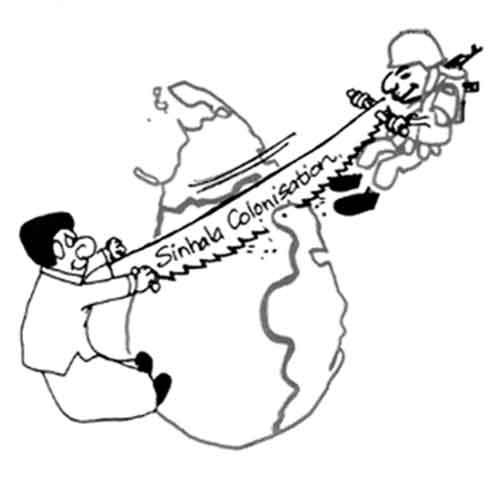
North and East Tamils traditional & historical homeland
In Sri Lanka for the last 72 years, the intent and goal of all Sri Lankan Governments and Buddhist Clergy [without exception] have been to secure the Island as a SINHALA BUDDHIST STATE. The current Sri Lankan President Gotabaya Rajapakshe is latest and very active leader who is determined to achieve this goal during his tenure.
The Sinhala Buddhist nation pretending as a multi-ethnic ‘civic’ Sri Lankan nation set about its task of assimilation and cleansing the Island of the Tamils and Muslims.
[1[ 1948: The Ceylon Citizenship Act, though providing the qualifications to be a citizen, was designed to disqualify persons of Indian origin. The provision said that “only a person born in Ceylon prior to the date of the Act coming into force, of a father born in Ceylon could be recognised as a citizen”. This decitizenized all persons of Indian origin since proof of birth of two generations was necessary.
“Everyone has the right to a nationality. No one shall be arbitrarily deprived of his nationality…”- Article 15, Universal Declaration of Human Rights
[2] Declaring the Lion Flag as the National Flag. .Senator S.Nadesan, an Independent Tamil Senator, dissented from the majority view. In his dissent dated 15 February 1950, he said:
“I regret that I am unable to agree with the majority decision of the National Flag Committee. In my view a national flag, apart from giving an honoured place to all communities, must also be a symbol of national unity.
[3] Colonizing parts of the Tamil homeland with Sinhalese people, especially to split the north and east to disconnect the areas connecting the North and East.
[4 Implementing Sinhala as the official language of Sri Lanka. In 1956 depriving the Tamils in public service and misery to those who are not fluent in Sinhala language/
[5] Discrimination against the Tamils students deeking Univercity Admission. This policy by the Sri Lankan government in 1971 to curtail the number of students selected to the Universities.
[6] Dishonoring agreements/pacts entered intoi with the Tamil leaders.
[7] Giving foremost place to Buddhism and state religion.
There appears to be no stopping of the already stained and eroded image of Sri Lanka in respect of human rights violations which commenced from 1948, immediately after the independence from the British. All the past Sinhalese leaders were competitions with each other to come to power by indulging in racial discrimination by oppressing the Tamils
In fact, it was the Tamil Leaders like Sri Ponnambalam Ramanathan [1851 – 1930] and Sir Ponnambalam Arunachalam [1853 – 1924] who spearheaded the struggle for independence from the British. However, the Ponnambalam brothers later realized that the Sinhalese politicians have let them down and foresaw that the Sinhalese leaders are very keen and trying to advance the interests of majority community at the expense of Tamil people. In his speech said: –
‘Why did the [Donoughmore} Commissioners not study Ireland, which Is next door to them? They [Irish] said that we are a lot, and you are another. We cannot work together. We must have separate governments. Then I ask what happened to the Dominion of Canada? The officials concerned said, it is an impossible situation…
When the attempts at ethnic cleansing by Sinhala/Buddhist majority governments [within the confines of a single state] were resorted by Tamil people by non-violent means.. The Sinhala/Buddhist governments resorted to violence against the Tamils in 1956, 1958, 1961, 1974, 1977, 1983.a murderous violence directed to terrorize the Tamils into submission.
Ethnic cleansing often occurs in stages. The preferred route of a conqueror is to achieve his objective without resort to violence – peacefully and stealthily. But when that fails, the would be conqueror turns to murderous violence and genocide to progress his assimilative agenda. Genocides do not just happen. And Sri Lanka is no exception to these general rules.
It is to be noted that the former UN High Commissioner for Human Rights Hon. Zeid Ra’ad Al Hussain expressed his concern over Sri Lanka’s slow progress in establishing transitional justice mechanisms to address accountability and emphasized the need for an agreement on a comprehensive strategy, with a timeline and detailed benchmarks, to address all transitional justice pillars identified in Resolution 30/1 of 2015 which was co-sponsored by Sri Lanka calling for full implementation.
A culture of entrenched impunity, especially for criminals of political parties, and state security forces and officials. One can count only very few who have been convicted of crimes against the Tamils since 1956, and this culture of entrenched impunity is still prevailing with no hope of redemption. This obnoxious practice is obviously emboldening and encouraging the security forces, politicians, and their supporters to the commission of crimes without any fear or prosecution.
It is apt to quote that Hon. Philippe Bolopion – UN Director at Human Rights Watch said
“The UN internal review identified the tragic mistakes that led to the UN to fail in its most terrific obligations to civilians in Sri Lanka”
“It is a call to action for the entire UN system” he said.
RULE BY A PERMANENT ETHNIC MAJORITY WITHIN THE CONFINES OF A SINGLE STATE IS THE DARK SIDE OF DEMOCRACY.
Kumarathasan Rasingam – Secretary, Tamil Canadian Elders for Human Rights Org.
 RSS Feed
RSS Feed















 November 14th, 2021
November 14th, 2021  Awake Goy
Awake Goy  Posted in
Posted in  Tags:
Tags: 













